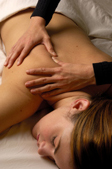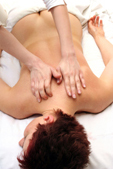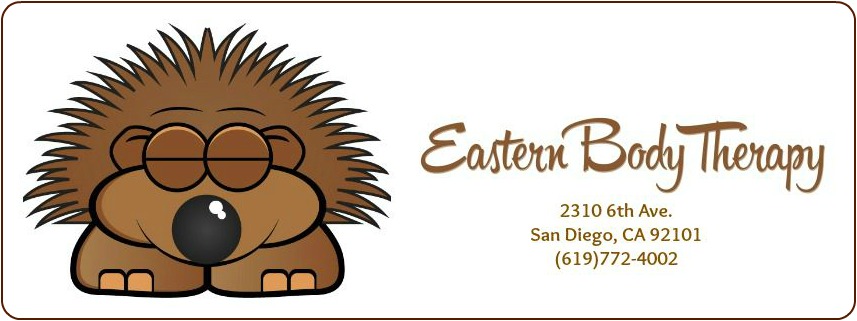Rub-a-Dub-Dub | Working Out the Kinks | Under My Thumbs | Needing to be Kneaded | Research | Print This Page
Massage is the use of rubbing, friction, tapping, and other techniques with the hands of the practitioner on the body of the patient. Massage has been used for thousands of years for everything from back pain to stress relief. It is a common service in spas and luxury hotels, and, thanks to the research of the Touch Research Institute, it is quickly gaining acceptance as a medical treatment for a variety of conditions. back to top

There are many theories about what massage does and why it works. Massage facilitates the flow of blood and lymph. Pressure on the muscles exerts pressure on the blood and lymphatic vessels which in turn pushes the fluid through the vessels. This is the basis for circulatory massage and lymphatic drainage techniques. Improved circulation of blood and lymph means that the body moves waste products out of muscle tissue more efficiently. It also allows for better oxygenation to the muscle tissues. This all allows for better muscle function and less pain for the patient.
When the practitioner exerts strong direct pressure on a muscle, the muscle's natural tendency is to contract against the pressure. When a muscle contracts, there is an exchange of calcium and potassium ions across the cell membranes of the muscle. Calcium is needed for the muscle to contract, and there is a limited amount of calcium in the tissue at any given time. After a period of strong, continuous contraction, the muscle exhausts its store of calcium and is no longer able to contract. This is experienced by the patient as an abrupt relaxation and softening of the muscle.
Sometimes the body contracts muscles in order to protect an injured area. This is a great protective mechanism when there is an injury, but somtimes the contraction continues long beyond when the protection is really needed. The body knows how to turn this mechanism on, but does not always know when to turn it off. When a muscle is forced to release because its calcium has been exhausted, the cycle of contraction is broken. Often, if the protection is no longer needed, the release is permanent (until the next injury, of course). back to top

There are many styles of massage, and most practitioners are trained in a variety of styles and techniques. Usually, the patient is asked to disrobe either completely or to the level of undergarments in order to have more skin available to treat. They are then asked to lie on a massage table, covered by a sheet or a blanket. Treatment may involve rubbing, stroking, pinching or grasping, tapping, or rolling with the practitioners hands, fingers, or elbows. Areas treated may include the back, abdomen, shoulders, arms, legs, feet, hands, face, head, etc.
Some styles of massage such as Shiatsu or Thai Massage are traditionally practiced on the floor with the patient dressed in loose, comfortable clothing. These styles use a combination of pressure on specific points and passive movement of the body (the practitioner moves the patient's body while the patient relaxes.) The practitioner may need to support the patient's body with her own, so knees, elbows and even the practitioner's legs may be used as part of the treatment.
A reputable therapist will always be concerned about the physical and emotional comfort of her patient, and will be careful to keep as much of the body covered as is reasonable to effectively treat the area being worked on. If at any time a patient is uncomfortable with the technique or feeling overly exposed, this should be discussed with the practitioner.
 Most patients experience a deep sense of relaxation when receiving massage. In a deep tissue, Shiatsu or trigger point style massage, there may be intense sensation at some times during the treatment. The level of sensation should always be tolerable to the patient, and communication between the patient and practitioner is critical to maintaining comfort. If there is pain, it should be a "hurts so good" sensation, not a "grit your teeth and bear it" sensation. After a massage, the patient should drink more water than usual to help flush out any lactic acid and other waste products released from the muscle tissue into the blood stream. There may be localized muscle soreness or a feeling of having had a work out which may last for a day or two. This is normal and should not generate concern on the part of the patient. It is not uncommon to feel more fatigued than usual for a day or two, especially after receiving deep massage work. This is a time to be patient with yourself and not try to reach new goals in working out or in physical therapy! back to top Most patients experience a deep sense of relaxation when receiving massage. In a deep tissue, Shiatsu or trigger point style massage, there may be intense sensation at some times during the treatment. The level of sensation should always be tolerable to the patient, and communication between the patient and practitioner is critical to maintaining comfort. If there is pain, it should be a "hurts so good" sensation, not a "grit your teeth and bear it" sensation. After a massage, the patient should drink more water than usual to help flush out any lactic acid and other waste products released from the muscle tissue into the blood stream. There may be localized muscle soreness or a feeling of having had a work out which may last for a day or two. This is normal and should not generate concern on the part of the patient. It is not uncommon to feel more fatigued than usual for a day or two, especially after receiving deep massage work. This is a time to be patient with yourself and not try to reach new goals in working out or in physical therapy! back to top
In addition to release of muscle contraction and spasm noted above, massage can help to improve circulation, decrease pain, and reduce stress. Research by the Touch Research Institute, a division of the medical school at the University of Miami, has shown that just 15 minutes of massage can improve concentration and increase ability to do complex calculations.(1) The Touch Research Institute has also shown massage to reduce blood glucose levels in children with diabetes (2), reduce blood pressure (4), reduce pain and improve sleep in fibromyalgia patients (3), and improve the overall sense of well-being. Massage has been shown to be beneficial for everyone, from premature infants needing touch to senior citizens and everyone in between. back to top
(1) Field, T., Ironson, G., Scafidi, F., Nawrocki, T., Gonclaves, A., Burman, I., Pickens, J., Fox, N., Schanberg, S., & Kuhn, C. (1996). Massage therapy reduces anxiety and enhances EEG pattern of alertness and math computations. International Journal of Neuroscience, 86, 197-205.
(2) Field, T., Hernandez-Reif, M., LaGreca A., Shaw, K., Schanberg, S., & Kuhn, C. (1997). Massage therapy lowers blood glucose levels in children with Diabetes Mellitus. Diabetes Spectrum 10, 237-239.
(3) Field, T., Diego, M., Cullen, C., Hernandez-Reif, M., Sunshine, W., & Douglas, S. (2002). Fibromyalgia pain and substance P decrease and sleep improves after massage therapy. Journal of Clinical Rheumatology, 8, 72-76.
(4) Hernandez-Reif, M., Field, T., Krasnegor, J., Theakston, H., Hossain, Z., & Burman, I. (2000). High blood pressure and associated symptoms were reduced by massage therapy. Journal of Bodywork and Movement Therapies, 4, 31-38. back to top
|

 Yelp About Us
Yelp About Us 


 Most patients experience a deep sense of relaxation when receiving massage. In a deep tissue, Shiatsu or trigger point style massage, there may be intense sensation at some times during the treatment. The level of sensation should always be tolerable to the patient, and communication between the patient and practitioner is critical to maintaining comfort. If there is pain, it should be a "hurts so good" sensation, not a "grit your teeth and bear it" sensation. After a massage, the patient should drink more water than usual to help flush out any lactic acid and other waste products released from the muscle tissue into the blood stream. There may be localized muscle soreness or a feeling of having had a work out which may last for a day or two. This is normal and should not generate concern on the part of the patient. It is not uncommon to feel more fatigued than usual for a day or two, especially after receiving deep massage work. This is a time to be patient with yourself and not try to reach new goals in working out or in physical therapy!
Most patients experience a deep sense of relaxation when receiving massage. In a deep tissue, Shiatsu or trigger point style massage, there may be intense sensation at some times during the treatment. The level of sensation should always be tolerable to the patient, and communication between the patient and practitioner is critical to maintaining comfort. If there is pain, it should be a "hurts so good" sensation, not a "grit your teeth and bear it" sensation. After a massage, the patient should drink more water than usual to help flush out any lactic acid and other waste products released from the muscle tissue into the blood stream. There may be localized muscle soreness or a feeling of having had a work out which may last for a day or two. This is normal and should not generate concern on the part of the patient. It is not uncommon to feel more fatigued than usual for a day or two, especially after receiving deep massage work. This is a time to be patient with yourself and not try to reach new goals in working out or in physical therapy!